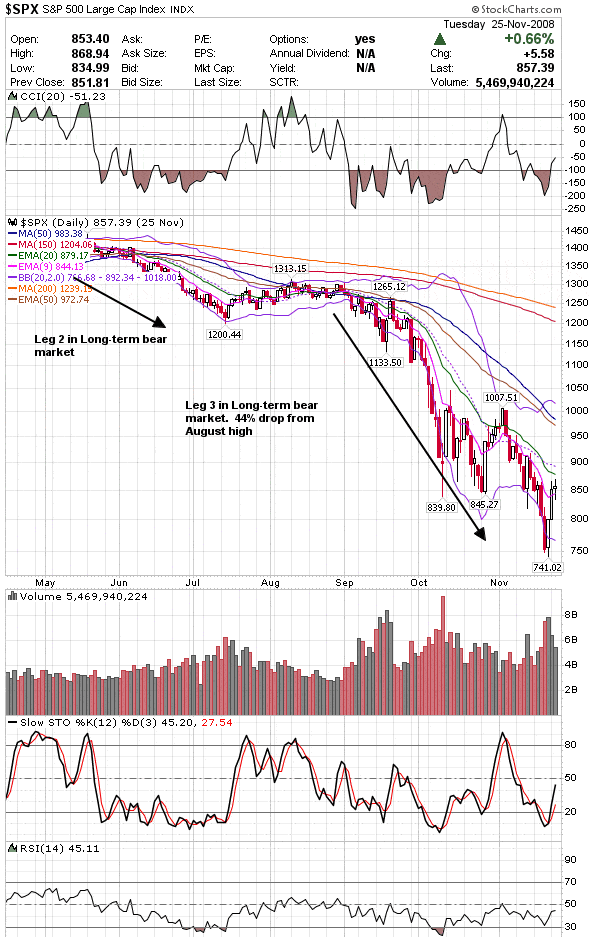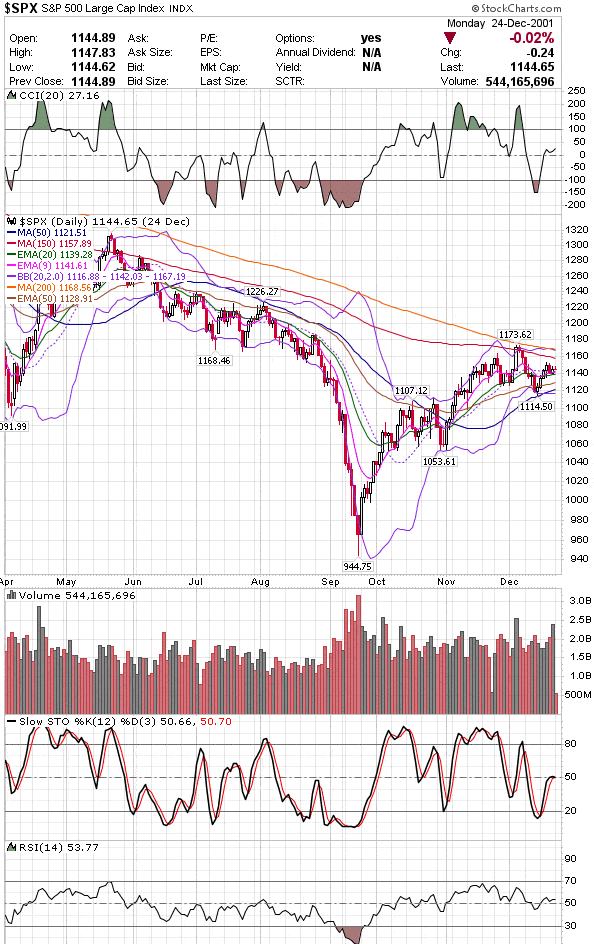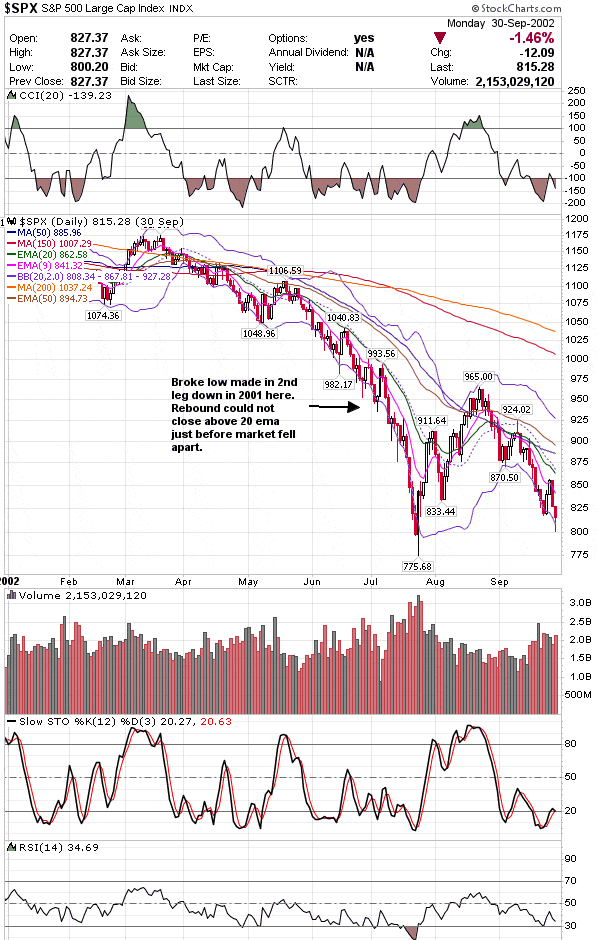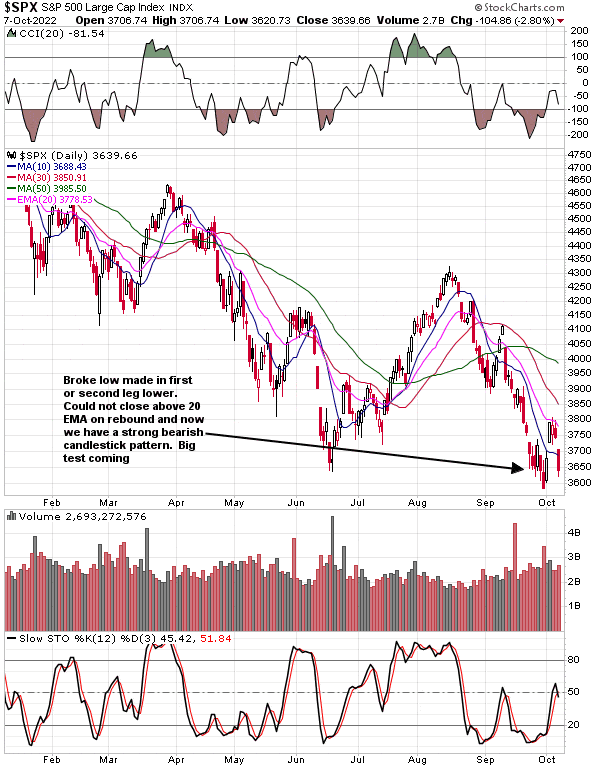Swing Trading a Market Crash
As mentioned in a previous blog article, the biggest crashes on the major indices tend to occur towards the end of a bear market. Although the S&P 500 had about a 35% drawdown in the early phases of the pandemic, the S&P 500 has dropped much more during the later phases of bear markets.
In 2008, the market dropped 44% from a prior swing high in August to the lows in November 2008 for instance. This move in August started well off the highs that occurred almost a year earlier. So long, drawn out downtrends in the major market indices need to be followed carefully when trading.
As always, we are looking to trade the overall trend in the market. This is especially true when trading long, entrenched downtrends where we want to buy puts or short more often.
With talk of credit default swaps on major European banks reaching all-time highs, the market is obviously very interested in buying some kind of insurance from a banking crisis and contagion.
Even though this still seems to be the 2nd leg lower in a long-term bear market, it could actually be the third. The 2nd leg lower only takes out the prior low by about 5% to 15% historically. So this would take us to about the pre-pandemic highs. A third leg lower is often much worse.
The Fed is Still Hiking so Why Would the Market Crash?
In past bear markets, the Fed had already cut rates when the crushing third leg lower in a long-term bear market occurred. This was true in late 2008 and 2002.
However, the Fed was not constrained by a pandemic or looming Ukraine invasion back then either. So, perhaps things will happen more quickly this time around since they are running to catch up with triple rate hikes each meeting.
Then again, the current news seems to be more reminiscent of early 2008 before Bear Stearns famously went belly up to kick off the financial crisis. The crash did not really start until the fall of the that year.
The one thing that gives the bulls hope is a very resilient labor market since the corporate tax cut passed several years ago. This is the second time the unemployment rate has gotten back down to around 3.5% so perhaps the economy can actually handle a 4.5% fed funds rate. Also, the Atlanta Fed GDP Now forecast for Q3 is now up to 2.9% after being just .3% earlier last month which was at least partially due to changes in imports/exports.
On the other hand, the 40 year bond bull market is ending before our very eyes. Back in 2020 we noted how the chart of the ten-year yield looked like a blow off top in the bond market to subscribers. An event that often occurs in very long-term bull markets.
Since then, bond yields have gone to levels not seen in over a decade. Remember, bond yields go higher when bond prices move lower. So you can flip the long-term chart of the ten-year yield on its x-axis to see the blow off move in 2020.
Smooth End to Multi-Decade Bull Market?
So will this multi-decade bull market in bonds end with a smooth transition? We may have seen investors answer to this question on Friday.
The jobs number on Friday was more-or-less a yawner. Basically numbers that about met expectations across the board.
Yet the market gapped much lower and then tanked from there. Volume was higher than the day before.
So was a jobs report that fell short of expectations in total jobs bearish? Why? The market already expected about that many jobs created and wage gains.
Was a number that met expectations much more inflationary than the day prior? Not really. Yet investors were lined up willing to dump stocks all day long.
So this makes us think it may be time to get ready for a potential crash sooner rather than later. Lets hope not but its good to be prepared because trading put options or shorting can be very profitable during a crash.
The signs of a Market Crash
In 2008, it was fannie mae going into receivership that was one of the clear signs the crash was coming. Then it was the “Lehman moment” that really kicked off the selling in earnest. Polls were also showing that the most far left senator at the time was about to become president.
All of these factors led to one of the greatest crashes of our time. During this time, we had one of our most profitable trades on a percentage basis. A more than 500% profit in 1 trading day trading puts on fannie mae.
This time around it will likely be the credit default swaps on the European banks all soaring higher in price in the days or weeks ahead. The “big boys” in the finance world in Europe may have to get together at some point and try to work something out given the inflationary forces coming this winter.
With inflation raging, one wonders what that “deal” will be.
So we can expect emergency measures and a big bailout proposed at some point in the weeks or months ahead. Maybe just days.
The Technicals
The real sign for us that we may be starting a crash is if the S&P 500 takes out the prior lows of 3584 in the days ahead. If this occurs and closes below it on strong volume, it may be time to get your puts on. We would also want to see some very bearish news along with the move. Perhaps worse-than-expected CPI and PPI later this week.
Again, the prior low could hold or we could see a strong rebound right after breaking that low. However, when trading, we have to be prepared to profit in either direction.
So this study may be more for later next year if and when unemployment rates surge higher. But its good to look at daily and 1 hour charts of the S&P 500 during recent market crashes.
What if the Lows Hold?
We think its more likely that the market either holds around here or goes down to around the pre-pandemic highs which is less than 10% below the June lows. Not 20% to 30% below the June lows. At least for now.
Either way, we will be swing trading and day trading the market trend. Who knows? Maybe CPI and PPI numbers will finally crack next week and we will see a big rally starting. Perhaps US bank executives will tell us the contagion risk in Europe is miniscule at worst. Time will tell.
If that occurs and we get a strong bullish trend change signal, we will be trading some big earnings gaps and bottoming patterns in the weeks ahead. Probably more so in late October or early November just ahead of and after the mid-term election.
The Mistake in Applying Investing Principles to Swing Trading
A lot of financial pundits and advisors will tell you that you cannot time the market. There is no way to beat it so you may as well just dollar cost average or maybe just buy more if it goes down further.
This is good advice for most investors but this site is about the small portion of an overall portfolio dedicated to trading.
Investment professionals will tell you that all known information is priced into the market all the time. Well, we just saw multiple occasions this year where inflation and/or the Fed increased future funds rate expectations significantly.
Did the market reprice 10% or more within a minute? No, it took several days to make the move lower because large investors cannot sell all at once. Their positions are so large that it takes days or weeks to unwind them.
This is also true with stocks that are being bought by funds. Fund managers take days, weeks or months building or selling positions in individual stocks. So traders can take advantage of the trends that develop in the stock after big news that was much better or worse than expected.
Swing Trading a Market Crash
This is one of those times where we could have a big catalyst and repricing that takes days or weeks to play out.
It could be to the upside or downside depending on how the news comes out in the weeks ahead. We also have to keep in mind that some investors will be holding off until after the mid-term election results are known with certainty through polling near the election. Of course, after that we have to be concerned about a Chinese military buildup near Taiwan.
So to start our preparation, lets look at prior market crashes after inflation rose and the Fed raised interest rates to tame it.
Here’s the 2008 crash:

Chart courtesy of StockCharts.com
Notice how the price broke the lows made in the 2nd leg lower, rebounded to the 50 day moving average and turned over strongly from there, then consolidated for a few days before going into the crash.
Here is the 2001 2nd leg lower in the 2000 to 2002 bear market.

Chart courtesy of StockCharts.com
In the 2nd leg lower, there was only a small consolidation before the market went much lower over the next week or so. The S&P 500 broke the prior bear market lows and then dropped another 13%+ within a couple weeks.

Chart courtesy of StockCharts.com
In 2002, the market took the third leg lower in a long-term bear market, broke the low made in the 2nd leg lower, then rebounded briefly without closing above the 20 EMA, then proceeded to crash about 18% below the lows over the next few weeks.
Now here is the current 2022 S&P 500 chart

Looks a little ominous right now but a lot depends on the news next week and during earnings season. Lets hope the inflation numbers are better and credit default swaps in Europe start to calm down. Currently, some are more expensive than in 2008.
Notice that during the crashes, the S&P 500 did not close above the 9 EMA until we saw about a 14% to 38% move lower. A 15% move lower would take the S&P 500 to about 3100.
So we could use the 9 EMA as a stop on a short or put options on the SPY. Perhaps a close above the 9 EMA and then a move above that days high the next day. We could take some off around the pre-pandemic high and hold the remainder for a potential move 30% below the June lows with the stop mentioned above.
Just a trading idea. We want to see strong bearish news with the break of the lows. Without the fresh news, its more likely to rebound a lot sooner.
Things to Keep in Mind
The 2nd leg lower in the 2008 bear market only went about 5% below the low made during the first leg lower. So perhaps we will find support around 3450 and this will be a 2nd leg lower before the final legs next year during a full-on recession with a sharp increase in unemployment.
There is also a chance that this will turn out to be just an elongated growth scare that some bulls are sticking to at this point. Many leading indicators for inflation are pointing downward but then we got the big CPI number last month for the month of August even though leading indicators for inflation were improving. OPEC just announced production cuts that ended the decline in oil prices as well.
Also, UK bond yields started to blow up and the bank of England had to intervene to prevent a bigger problem by buying up lots of bonds. The credit default swaps, which is a form of insurance on bank bonds, soared to prices above the peak during the financial crisis for Credit Suisse. However, Credit Suisse also passed a recent US stress test.
As a swing trader, we have to be ready for anything. A big CPI number next week or bigger concerns about banks and bonds around the world could trigger a strong move below the June lows.
The end of the Bear Market?
The good news? A big third leg lower in the market often marks the beginning of the end. The beginning of the end of a bear market that is. Once the dust settles, you normally see some of the best long-term buying opportunities in many years. So lets hope this is the third leg.
Stay tuned. The next few weeks could be the most important of the year. A lot could be determined in October.
Perhaps we will see really good news next week or really bad news. So we will prepare to trade it in either direction once the news is released.
Our Top Longs and Shorts for the Weeks Ahead




